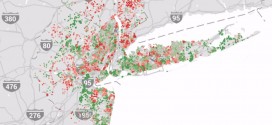The most populated segment of housing markets, mid-tier priced homes selling between $120,000 and $345,000 are the worst segment in terms of price appreciation, selling nearly 25 percent below peak levels, keeping the recovery locked into low gear
July data from Clear Capital revealed that the low-tier is closest to peak 2006 levels, with prices only 10.1% below 2006 peak levels, but the mid-tier is the worst performing segment with current price levels 24.8% below 2006 peak levels.
This vast difference in market recovery underscores the continued challenges the majority of homeowners face, despite a quicker recovery in both the bottom and top segments of the market, Clear Capital said.
“Our latest data exposed a mid-tier lag. This segment is still way behind both the top and bottom of the market in terms of recovery over the last nine years. When we analyzed the change in home prices since the summer of 2006, we observed that the mid-tier has lagged behind both the upper end and lower ends of the market by a surprisingly wide margin. At -24.8% below its peak level, the mid-tier is more than double that of the low-tier at -10.1% and more than 10 percentage points from the top-tier at -14.2%,” said Alex Villacorta, Ph.D., vice president of research and analytics at Clear Capital.
“The low-tier was both hit and buffered by high levels of distressed activity which, in recent years, has sparked investor activity driven in large part by the accelerated demand in the rental sector. And, the top-tier has benefited from a segment of the market that is more resilient to the current economic climate. The mid-tier’s performance is concerning as it represents the key move-up buyer segment of the market. As long as this key segment is still fighting to regain an equity foothold, re-engagement back into the purchase market will continue to be on hold,” he said.
Regionally, Clear Capital observed a small uptick in quarterly gains in both the West and Midwest, between 0.3 to 0.1 percentage points, while the Northeast and South remained unchanged over the quarter, at 0.2% and 0.8%, respectively. These minimal changes reinforce housing’s continued moderation and suggest the initial thrust of the home buying season is starting to wane.
However, disparity still exists at the local market level. The Northeast reports the widest gap in price performance between the top and bottom performing MSAs with Pittsburgh and Providence at 14.1% and -14.1% year-over-year (Charts 1 and 2).
“Through the first half of 2015, we observed a housing recovery that is normalizing after an impressive price surge from the trough of the market,” said Dr. Villacorta, Ph.D.. “After more than two years of a pretty remarkable upward swing, the housing market’s correction-to-the-correction has given way to more normal rates of growth. What we now know, however, is that this correctionary period has not treated all markets, nor segments within markets, the same. In the present environment, micro analysis is key.”
| National and Regional Markets | ||||||
| Market | Qtr/Qtr | Yr/Yr | Distressed Saturation | |||
| National | 0.7% | 5.1% | 15.4% | |||
| West | 1.3% | 7.4% | 10.8% | |||
| Northeast | 0.2% | 2.2% | 14.3% | |||
| South | 0.8% | 5.8% | 18.6% | |||
| Midwest | 0.4% | 4.4% | 17.9% | |||
| Chart 1. National and Regional Markets Through July 2015. Source: Clear Capital | ||||||
| Highest Performing Major Metro Markets | ||||||||
| Qtr/Qtr Rank |
Metropolitan Statistical Area | Qtr/Qtr | Yr/Yr | Distressed Saturation | ||||
| 1 | Las Vegas, NV – Paradise, NV | 1.7% | 6.8% | 18.5% | ||||
| 2 | Dallas, TX – Fort Worth, TX – Arlington, TX | 1.7% | 10.2% | 3.7% | ||||
| 3 | Seattle, WA – Tacoma, WA – Bellevue, WA | 1.6% | 10.4% | 12.0% | ||||
| 4 | Denver, CO – Aurora, CO | 1.6% | 11.3% | 6.4% | ||||
| 5 | Tampa, FL – St. Petersburg, FL – Clearwater, FL | 1.5% | 8.2% | 27.8% | ||||
| 6 | Miami, FL – Ft. Lauderdale, FL – Miami Beach, FL | 1.4% | 9.7% | 24.8% | ||||
| 7 | Sacramento, CA – Arden, CA – Roseville, CA | 1.4% | 7.2% | 12.0% | ||||
| 8 | Phoenix, AZ – Mesa, AZ – Scottsdale, AZ | 1.4% | 6.6% | 11.1% | ||||
| 9 | Pittsburgh, PA | 1.4% | 14.1% | 9.2% | ||||
| 10 | San Francisco, CA – Oakland, CA – Fremont, CA | 1.3% | 8.3% | 6.0% | ||||
| 11 | Los Angeles, CA – Long Beach, CA – Santa Ana, CA | 1.3% | 7.7% | 8.9% | ||||
| 12 | Riverside, CA – San Bernardino, CA – Ontario, CA | 1.2% | 7.5% | 13.0% | ||||
| 13 | Portland, OR – Vancouver, WA – Beaverton, OR | 1.2% | 7.4% | 9.7% | ||||
| 14 | Orlando, FL | 1.2% | 6.5% | 30.4% | ||||
| 15 | San Jose, CA – Sunnyvale, CA – Santa Clara, CA | 1.2% | 8.2% | 3.9% | ||||
| Chart 2. Highest Performing Major Metro Markets Through July 2015. Source: Clear Capital | ||||||||
| Lowest Performing Major Metro Markets | ||||||||
| Qtr/Qtr Rank |
Metropolitan Statistical Area | Qtr/Qtr | Yr/Yr | Distressed Saturation | ||||
| 1 | Providence, RI – New Bedford, MA – Fall River, MA | -2.7% | -14.1% | 16.1% | ||||
| 2 | Baltimore, MD – Towson, MD | -0.4% | -2.9% | 26.7% | ||||
| 3 | Cleveland, OH – Elyria, OH – Mentor, OH | -0.3% | 0.5% | 19.0% | ||||
| 4 | Hartford, CT – West Hartford, CT – East Hartford, CT | 0.0% | -2.3% | 20.4% | ||||
| 5 | Milwaukee, WI – Waukesha, WI – West Allis, WI | 0.0% | 5.3% | 16.6% | ||||
| 6 | Boston, MA – Cambridge, MA – Quincy, MA | 0.1% | 0.7% | 9.5% | ||||
| 7 | Cincinnati, OH – Middletown, OH | 0.1% | 3.0% | 19.2% | ||||
| 8 | New Orleans, LA – Metairie, LA – Kenner, LA | 0.2% | 4.6% | 17.9% | ||||
| 9 | Rochester, NY | 0.2% | 1.2% | 8.7% | ||||
| 10 | Dayton, OH | 0.3% | 4.5% | 19.8% | ||||
| 11 | Washington, DC – Arlington, VA – Alexandria, VA | 0.3% | 2.1% | 13.3% | ||||
| 12 | Richmond, VA | 0.4% | 4.5% | 14.9% | ||||
| 13 | Houston, TX – Baytown, TX – Sugar Land, TX | 0.5% | 9.3% | 4.1% | ||||
| 14 | Louisville, KY | 0.6% | 4.1% | 13.8% | ||||
| 15 | Raleigh, NC – Cary, NC | 0.6% | 4.2% | 6.4% | ||||
| Chart 3. Lowest Performing Major Metro Markets Through July 2015. Source: Clear Capital | ||||||||
 RealEstateEconomyWatch.com Insight and Intelligence on Residential Real Estate
RealEstateEconomyWatch.com Insight and Intelligence on Residential Real Estate

